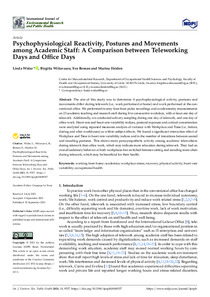Psychophysiological reactivity, postures and movements among academic staff: a comparison between teleworking days and office days

Widar, Linda ; Wiitavaara, Birgitta ; Boman, Eva ; Heiden, Marina
International Journal of Environmental Research and Public Health
2021
18
18
9537
work at home ; telework ; office work ; stress evaluation ; physical mobility ; heart rate monitoring ; occupational health ; work posture
Working conditions
https://doi.org/10.3390/ijerph18189537
English
Bibliogr.
"The aim of this study was to determine if psychophysiological activity, postures and movements differ during telework (i.e., work performed at home) and work performed at the conventional office. We performed twenty-four-hour pulse recordings and accelerometry measurements on 23 academic teaching and research staff during five consecutive workdays, with at least one day of telework. Additionally, we conducted salivary sampling during one day of telework, and one day of office work. Heart rate and heart rate variability indices, postural exposure and cortisol concentration were analyzed using repeated measures analysis of variance with Workplace and Time (i.e., before, during and after workhours) as within-subject effects. We found a significant interaction effect of Workplace and Time in heart rate variability indices and in the number of transitions between seated and standing postures. This shows more parasympathetic activity among academic teleworkers during telework than office work, which may indicate more relaxation during telework. They had an overall sedentary behavior at both workplaces but switched between sitting and standing more often during telework, which may be beneficial for their health."
Digital
The ETUI is co-funded by the European Union. Views and opinions expressed are however those of the author(s) only and do not necessarily reflect those of the European Union or the ETUI.